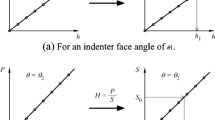Abstract
The article presents a combined experimental and theoretical method of determining strength characteristics of materials in high-speed tensile tests on specimens with shortened gauge length in which there is no region of uniaxial state of stress. Numerically, by the finite element method, zones of nonuniaxial state of stress over the gauge length of the specimen are established.
Similar content being viewed by others
Literature cited
G. V. Stepanov, Elastoplastic Deformation of Materials under the Effect of Impulsive Loads [in Russian], Naukova Dumka, Kiev (1970).
E. M. Morozov and G. P. Nikishkov, The Finite Element Method in Fracture Mechanics [in Russian], Nauka, Moscow (1980).
Author information
Authors and Affiliations
Additional information
Translated from Problemy Prochnosti, No. 9, pp. 26–28, September, 1991.
Rights and permissions
About this article
Cite this article
Astakhov, M.M., Loginov, A.V., Loshmanov, L.P. et al. Combined experimental and theoretical method of determining strength characteristics of materials under quasistatic tensile conditions. Strength Mater 23, 963–966 (1991). https://doi.org/10.1007/BF00770922
Issue Date:
DOI: https://doi.org/10.1007/BF00770922




